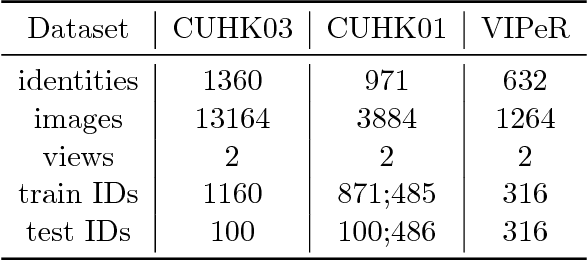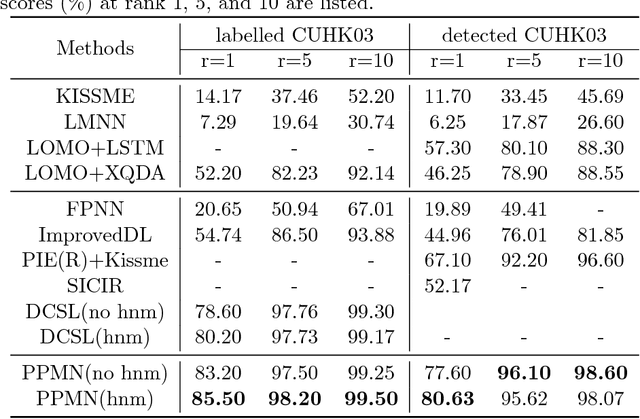Yaqing Zhang
Multi-Channel Pyramid Person Matching Network for Person Re-Identification
Mar 07, 2018



Abstract:In this work, we present a Multi-Channel deep convolutional Pyramid Person Matching Network (MC-PPMN) based on the combination of the semantic-components and the color-texture distributions to address the problem of person re-identification. In particular, we learn separate deep representations for semantic-components and color-texture distributions from two person images and then employ pyramid person matching network (PPMN) to obtain correspondence representations. These correspondence representations are fused to perform the re-identification task. Further, the proposed framework is optimized via a unified end-to-end deep learning scheme. Extensive experiments on several benchmark datasets demonstrate the effectiveness of our approach against the state-of-the-art literature, especially on the rank-1 recognition rate.
Pyramid Person Matching Network for Person Re-identification
Mar 07, 2018



Abstract:In this work, we present a deep convolutional pyramid person matching network (PPMN) with specially designed Pyramid Matching Module to address the problem of person re-identification. The architecture takes a pair of RGB images as input, and outputs a similiarity value indicating whether the two input images represent the same person or not. Based on deep convolutional neural networks, our approach first learns the discriminative semantic representation with the semantic-component-aware features for persons and then employs the Pyramid Matching Module to match the common semantic-components of persons, which is robust to the variation of spatial scales and misalignment of locations posed by viewpoint changes. The above two processes are jointly optimized via a unified end-to-end deep learning scheme. Extensive experiments on several benchmark datasets demonstrate the effectiveness of our approach against the state-of-the-art approaches, especially on the rank-1 recognition rate.
Text Coherence Analysis Based on Deep Neural Network
Oct 21, 2017



Abstract:In this paper, we propose a novel deep coherence model (DCM) using a convolutional neural network architecture to capture the text coherence. The text coherence problem is investigated with a new perspective of learning sentence distributional representation and text coherence modeling simultaneously. In particular, the model captures the interactions between sentences by computing the similarities of their distributional representations. Further, it can be easily trained in an end-to-end fashion. The proposed model is evaluated on a standard Sentence Ordering task. The experimental results demonstrate its effectiveness and promise in coherence assessment showing a significant improvement over the state-of-the-art by a wide margin.
 Add to Chrome
Add to Chrome Add to Firefox
Add to Firefox Add to Edge
Add to Edge